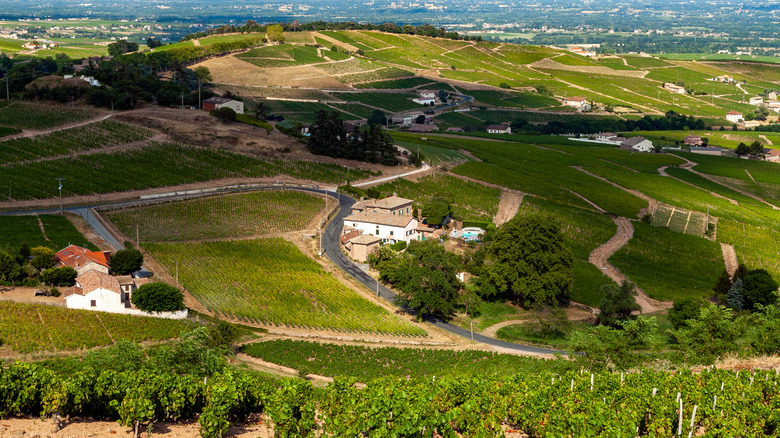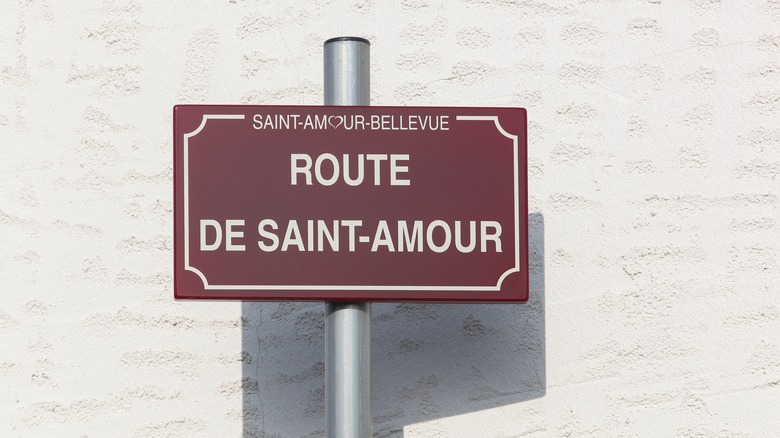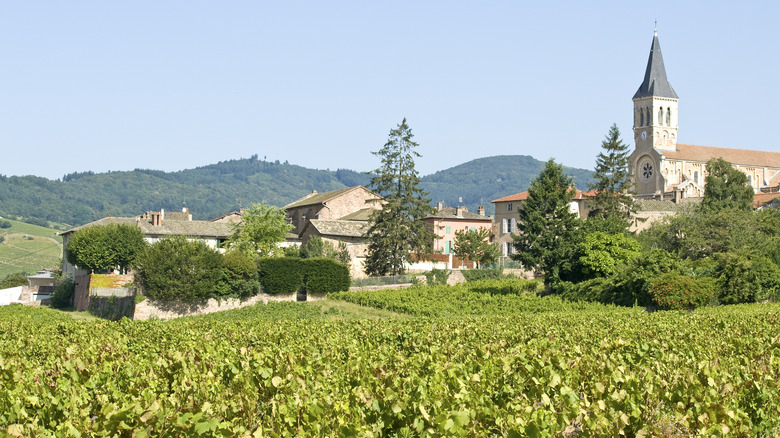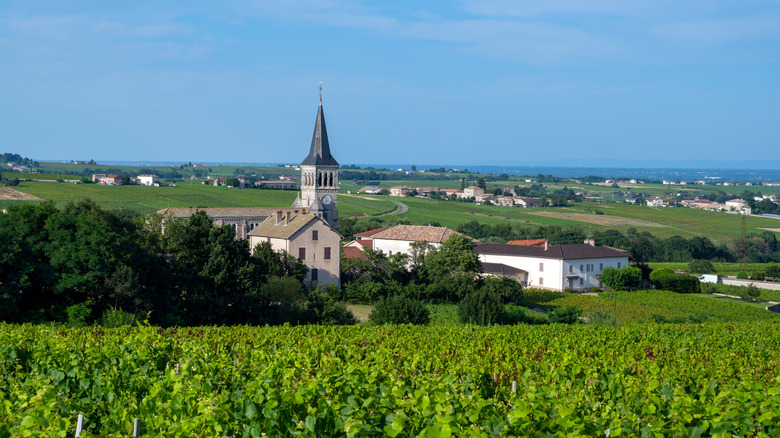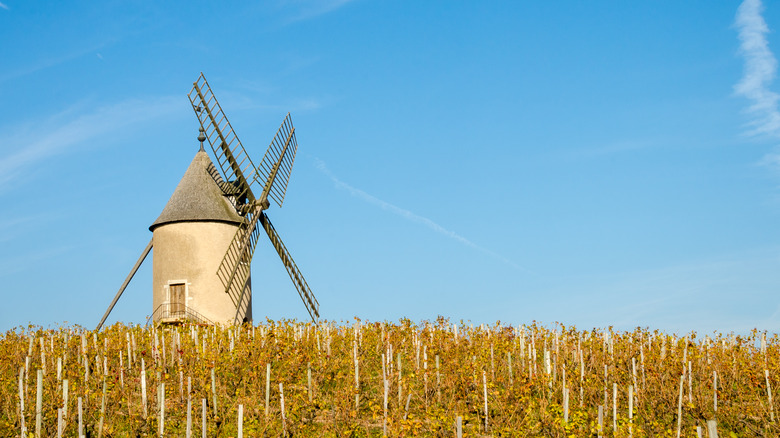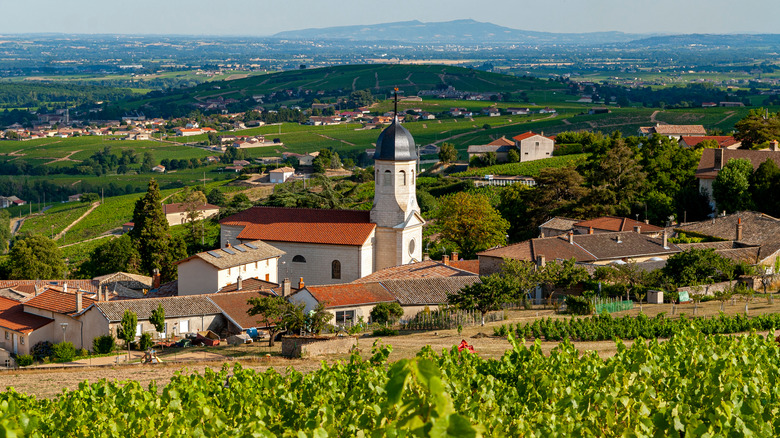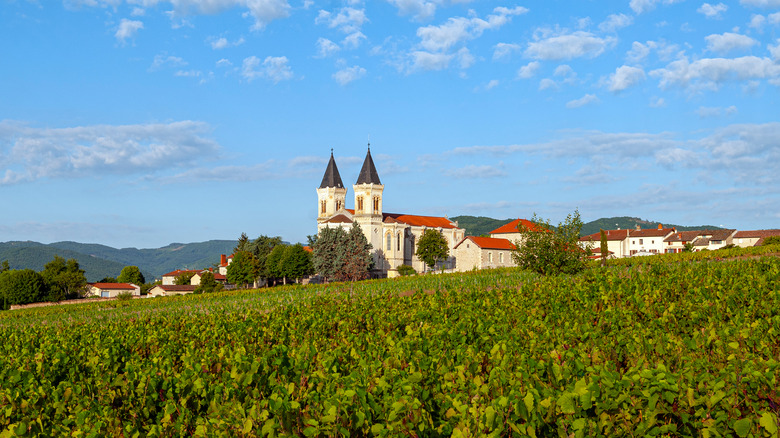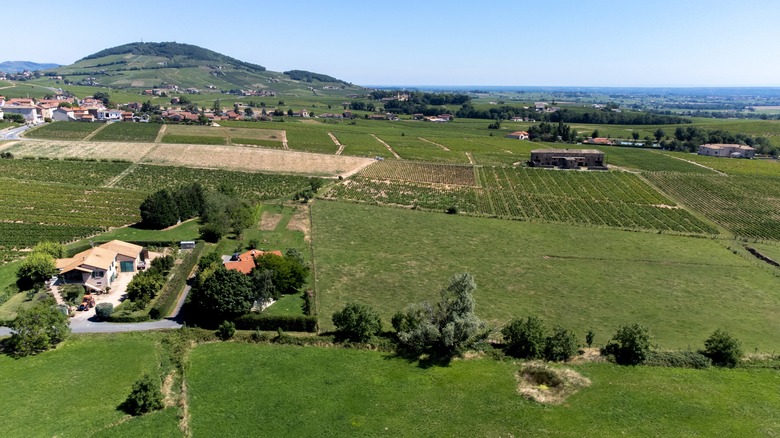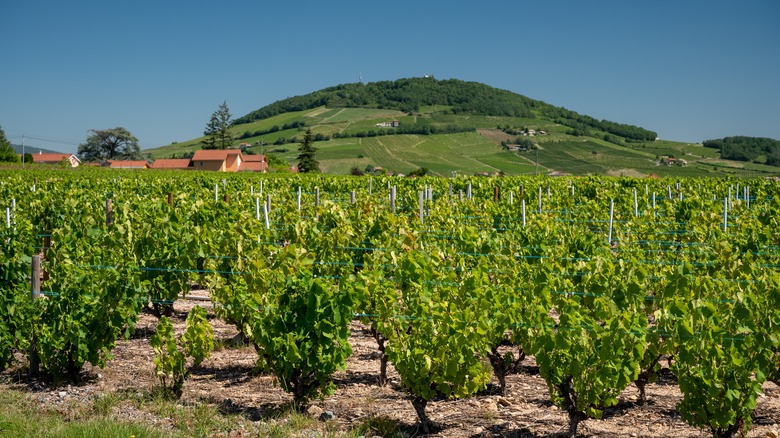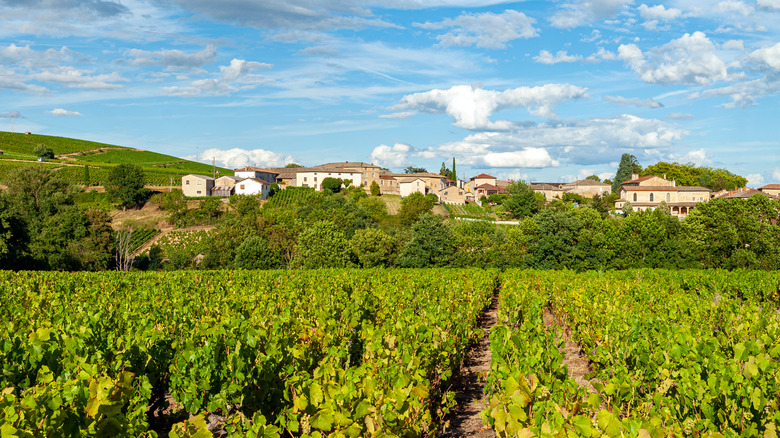A Guide To The 10 Crus Of France's Beaujolais Wine Region
Beaujolais is a French wine-growing area located between Mâcon (in Burgundy) to the north and the city of Lyon (near the Rhône Valley) to the south. It's a region that relies mainly on one grape: gamay — much of which is found in untrellised gobelet-style vineyards. Beaujolais makes up for the lack of varietal diversity with other dynamic assets and hundreds of soil profiles spread across a dozen growing appellations.
In accordance with French wine regulations, for a bottle to claim an origin site, it must be produced based on the rules of the region. In Beaujolais, this means that a bottle could be labeled in several ways: Beaujolais, Beaujolais Villages, or with the name of one of ten crus (these are specific growing sites within the region that are positioned parallel to the Saone River). Only red wines made from the gamay grape are eligible to be labeled Beaujolais cru.
Within each cru are many lieux-dits — or, specific geographical areas of a vineyard that are known for their own topographic characteristics — with notable distinctions. These are defined by the appellations themselves. Recent attention to soil mapping (documented by InterBeaujolais and summarized here) and meticulous distinguishment of terroir make this a particularly exciting era to explore. Isabelle Letessier of Sigales is largely responsible for soil study and mapping. It's work that the wine industry relies on to explain the lay of the land in Beaujolais.
Let's discover each of the Beaujolais crus and find out what makes them unique for the table or cellar.
Saint-Amour is more than romance
Situated in the northern reaches of the Beaujolais cru zone, Saint-Amour (located in the commune of Saint-Amour-Bellevue) attracts a fair share of admirers who are looking for love. Or at least a lovely bottle of wine. As the story goes, a Roman soldier (so much of French wine history seems to include something Roman) converted to Christianity and founded a monastery nearby, according to the Saint-Amour wine council. The village promotes this reputation by holding Valentine's Day weddings and vow renewals at the town hall (via Saint-Amour-Bellevue).
The soil here is heterogenous — from sandy to granite to alluvial deposits. The geological map here is complex. Key lieux-dits include En Paradis, À la Folie, Côte de Besset, Les Ravinets, Hameau des Billards, Vers l'Église, Aux Terres de Guinchay, Clos du Chapitre, La Pirolette, and Au Breuil. Thanks to soil diversity, Saint-Amour is associated with both bright and fruity wines as well as spicy and complex bottlings. The Cru Saint-Amour council says that the offerings are "part angel, part demon" as a way to illustrate the spectrum of aspects that can shine through in the wine depending on the terroir.
Juliénas has a notable name
Legend has it that this cru is named for Julius Caesar, who occupied this part of France. Although some wonder if his namesake is actually the nearby village of Jullié, according to the official Cru Juliénas site. Mostly located in the Rhône area, with a bit in Saône-et-Loire, Juliénas covers four communes (villages): Jullié, Pruzilly, Emeringes, and the town of Juliénas. This village is welcoming to visitors, featuring the remains of Gallo-Roman tombs and the Cellier de la Vieille Eglise (which offers wine tasting in a decommissioned church).
The spot gets adequate sun and has some relatively steep vineyards. In terms of soil, there is very little granite and more of what's considered blue stone, a mix of slate and diorites (hard stone with visible crystals), schist, and some clay. The lieux-dits here are Les Capitans, Les Fouillouses, La Bottière, Les Mouilles, Vayolette, Beauvernay, Bessay, En Rizière, Bois de la Salle, and Cotoyon. These wines are fresh, aromatic, and sometimes a bit spicy when young, but have the chops to age a few years. In fact, more Juliénas producers these days are crafting structured, serious wines that can be enjoyed now or popped in the cellar.
Chénas is the smallest Beaujolais cru
Covering a surface area of fewer than 250 hectares, Chénas is the smallest Beaujolais cru according to the Inter Beaujolais wine council. It surrounds its neighbor Moulin-à-Vent in a hug, and in some spots shares a similar profile. It includes the communes of La Chapelle-de-Guinchay and Chénas, and was named after ancient oak forests that pre-date the Gallo-Romans (these oak forests were later removed for the plantation of vineyards). There are fascinating historical tales associated with this spot — it's said that Chénas was the only wine that King Louis XIII would put on his table. There are also intriguing stories of envy from nearby villages when Chénas wines were exported to Paris in the 18th century, according to the Cru Chénas council.
Soil composition varies in Chénas from east to west, with granite and piedmont deposits in almost equal measure throughout. Main lieux-dits include Aux Bois Retour, Les Brureaux, En Rémont, Les Journets, Les Gandelins, En Melardières, Les Daroux, En Perelle, En Nervat, and Aux Blémonts. These wines are silky and can be a touch spicy. Not much of it gets imported into the U.S., but for those who grab it, Chénas has aging potential.
Moulin-à-Vent has the picturesque windmill
While most of the Beaujolais crus take their name from a local village, Moulin-à-Vent is titled after the eponymous 15th-century windmill in the middle of the vines. This is not just for looks — the area gets plenty of wind, which helps with disease mitigation and also thickens the grape skins. There are two communes that are associated with Moulin-à-Vent: Romanèche-Thorins and Chénas. This is one of the most well-known crus in the U.S. market and elsewhere, and it has enjoyed a prestigious history. According to the Inter Beaujolais wine council, in the years before World War II, a bottle of Moulin-à-Vent sold for the same price as Vosne-Romanée 1er cru. Today, it can be 10 times more expensive and is considered a high-end wine!
The soil here is largely granite (pink granite on the hills) and piedmont, with limestone, sandstone, and marl. There are 71 lieux-dits across the cru's over 600 hectares, according to Jancis Robinson, including Aux Caves, Au Michelon, Les Vérillats, Champ de Cour, La Rochelle, Rochenoire, Le Moulin à Vent, Les Thorins, La Tour du Bief, and Le Dime. These wines can be elegant, powerful, and age-worthy. Depending on the producer, wines from this cru are crafted in both semi-carbonic macerations (a method commonly associated with Beaujolais) as well as in the Burgundy style with a traditional maceration.
Chiroubles has the highest vines in Beaujolais
Chiroubles, situated around the commune of the same name, has a distinct claim to fame. The vineyards are some of the highest in elevation in all of Beaujolais, which makes them the steepest (via Wine Searcher). This presents a challenging work environment for any grower, requiring physical effort in the hillside environment. According to the Chiroubles wine council, slopes can exceed 30 degrees and some vineyards are arranged on terraces in amphitheaters. This is also a lovely spot to take a stroll or embark on an easy hike to see the simple cadole (dry stone huts) structures, which were built to provide primitive protection from the weather for people working in the vineyards.
The soil composition is decidedly uniform, particular in comparison to some of the other Beaujolais crus — it's totally granitic, with various veins and weathered areas. Key lieux-dits include Bel-Air, Les Pontheux, Chatenay, Les Roches, Tempère, Fontenelle, Rochefort, Grille Midi, and Les Bonnes. Chiroubles wines are admired for their freshness, and the village is considered one of the most lovely in Beaujolais.
Régnié is the newest cru
The village of Régnié-Durette, as well as Lantignié, is home to the eponymous cru Régnié. While the other crus were established in the 1930s and 40s, Régnié was born in 1988 (via Cru Régnié). But that doesn't mean that viticulture is anything new here — like its neighbors, vineyard cultivation in Régnié dates back to Gallo-Roman times.
This is a highly granitic cru varied with piedmont formations. The inclines here exhibit soils in various evolutionary stages with unique features such as "blocks" of sandstone that add to the diversity, according to documentation from the Beaujolais wine council. Overall, Régnié wines are considered easy to drink (perfect for a wine-tasting party) and aromatic, with light and bright cherry characteristics. Notable lieux-dits include La Haute Plaigne, Les Chastys, Vallières, La Pierre, Les Reyssiers, Aux Bruyères, Oeillat, Croix Penet, Les Bois, and Les Braves
Brouilly has diverse geology
The southernmost Beaujolais cru, Brouilly is not only the largest (Jancis Robinson), but it's fascinatingly complex. Along with Côte de Brouilly, which is encased inside Brouilly, this cru is part of Terre des Brouilly, a collaboration that brings together the winegrowers of both places in a unified voice of promotion. If that sounds like a lot of Brouilly to keep track of, there's one more area you should get to know: Mont Brouilly, which features the chapel known as Notre-Dame aux Raisins — or our Lady of the Grapes. It is a highlight of Beaujolais and is classified as a UNESCO Global Geopark. Brouilly covers the communes of Odenas, Quincié-En-Beaujolais, Saint-Lager, Saint-Etienne-La-Varenne, Cercié, and Charentay.
The soil map is like a rainbow, encompassing pink granite, several types of limestone, calcareous marls, some blue stones, and schist. Lieux-dits include Saburin, Pissevieille, Briante, Pierreux, Combiaty, Les Platures, Les Nazins, La Roche, Les Bruyères, and La Terrière. Brouilly wines are well known in France and throughout the world and are admired for their pure fruit character and versatility.
Côte de Brouilly is the kingdom of blue stone
The vineyards on the slopes and summit of Mount Brouilly (mentioned above) fall within the Côte de Brouilly cru. This appellation includes four communes: Saint-Lager, Odenas, Quincié-en-Beaujolais, and Cercié. According to the council of Terres de Brouilly, a walking circuit to the top of the mountain is one of the most enjoyable ways to experience the setting and learn about its history. The chapel at the top is said to have been built by the winegrowers in the 19th century as an appeal to the heavens in the face of environmental challenges that sound familiar today — frost, hail, and powdery mildew.
The steeply sloped vineyards sit on blue stone, granite, and piedmont soil. Lieux-dits include Chardignon, L'héronde, Croix Dessaigne, Brouilly, Chavannes, Le Pavé, Godefroy, Berthaudières, and Côte De Brouilly. Côte De Brouilly wines are structured and can also age generously. In youth, they are aromatic and show red fruit, spice, and mineral characteristics.
Fleurie is recognized by a flowery name
Another cru with sloping vineyards that cascade down from a chapel-topped mountain, Fleurie is generally recognized by its name, which means "flowery" in French. The only commune in the zone is a town by the same title, Fleurie. According to the Cru Fleurie wine council, the name is not tied to gardens and blooms but rather to a Roman legionary named Florus.
The majority of the soils here are pink granite, with the top of the slopes of poorer quality and more clay for water retention near the base. Lieux-dits include La Madone (which is the name of the hill), Les Labourons, Grille-Midi, Les Moriers, Les Garants, La Presle, La Chapelle Des Bois, Grand Pré, La Roilette, and (not to be confused with the sparkling wine region), Champagne. These wines are considered to be in sync with their name — they're aromatic and delicate, but you'll find more structured bottlings coming from vineyards lower on the slopes.
Morgon has the largest village among the Beaujolais crus
Large and geologically diverse, Morgon contains the largest town in all of the crus: Villé-Morgon. Morgon is also known for its vineyards on the Côte du Py slopes. This cru is associated with a movement that began in the 1980s involving a group of rebellious-at-the-time winemakers that believed in low-interventionist, old-timey ways of farming and producing wine. Wine importer/merchant Kermit Lynch labeled these grape rebels the "Gang of Four." For many wine drinkers today, their method is recognized as natural winemaking, and Marcel Lapierre, Jean Foillard, Jean-Paul Thévenet, and Guy Breton (the gang) are considered icons.
The cru is built on several different soil zones including granite, blue stones, and alluvial soils on the foothills. There is also some clay, decomposing schist, and fractured volcanic rock. This is known locally as '"rotten rock" — or, la roche pourrie according to Jancis Robison. Lieux-dits include Aux Charmes, La Côte du Py, Les Micouds, Les Grands Cras, Corcelette, Bellevue, and Douby. Morgon wines are thought to improve over time, with fleshy fruit characteristics and a powerful structure.
